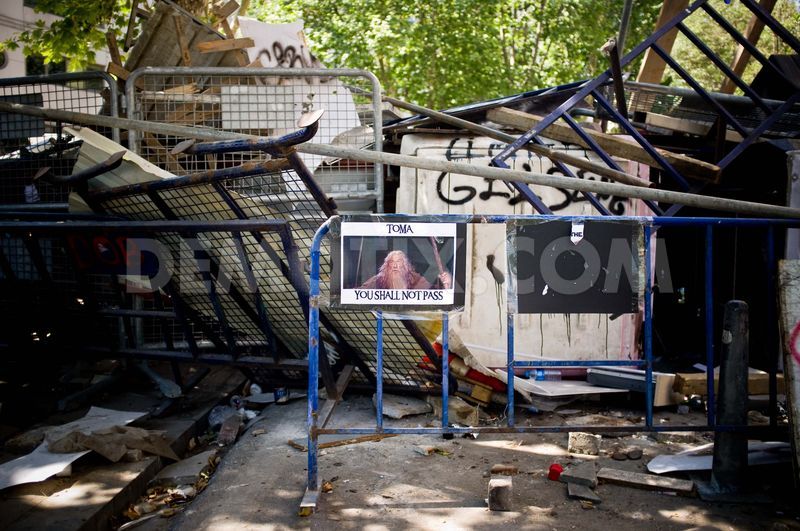The first barricade seems impenetrable. Hundreds of bricks piled high, torn fences, and flipped over cars mix into a single wide shield of corrugated steel with long metal spikes sticking out front, as if ready to defend against any horse charge. But then you walk another 10 meters and see the next one, twice as big, more bricks, more fences, graffiti all over it. And then walk a bit more and see another, and another, and another, and not only the main street but all the side streets and every surrounding street is blocked. All the sidewalks are sand, having their bricks taken out and put to new uses. Constant streams of people are hanging around each barricade, posing for photos; there’s vendors selling spray paint, gas masks and goggles in between each barricade. Iphones, ipads, and all i-devices are capturing the moments of joy and pride for all people. All ages join in jumping on the destroyed cars, playing inside the smashed out tractors, buses, media vans. Anonymous style guy fawkes masks are ubiquitous, as are vendors selling kofte, corn, tea, and of course, flags, thousands of red flags with the face of the founder of the republic, mustafa kemal ataturk, but also trotskyist, anarchist, feminist, and other flags. Anarchists mix with nationalists, while football hooligans and environmentalists, anti-capitalist muslims and LGBT Kurds all share every meter of soil within Gezi Park, making it shoulder-to-shoulder tight as you try to squeeze through from one side to the next. Tents on top of tents, a whole village lives within the park now. Construction materials from the stalled development litter the surrounding streets. Every piece of constant capital looks like rubble after a battle. The Ataturk cultural center, a five-story building on one side of Taksim square, is draped with massive banners saying “Don’t Obey”, “Tayyip Resign”, and huge flags of Ataturk, mixed with anarchist graffiti and football signs.
The whole thing seems medieval, with helmets, javelin poles, and a view of the Bosphprus, Hagia Sophia, and Blue Mosque in the horizon; the square itself is more of a carnival than anything else. Hundreds of thousands of people packed together, dancing, singing, chanting, hawking, just celebrating each other’s presence in a cop-free central zone for the first time in memory. Everyone is arguing, debating, laughing, telling stories of tear gas and trees. The police haven’t attacked for a few days, there’s just too many people, too many barricades. Every 20 minutes another march comes through with another chant, sometimes kemalist, sometimes communist, sometimes a song, sometimes a prayer. A mix of youth, students, activists, families, and travelers set up picnics, tables, and booths selling whatever ideology or product they have. If it wasn’t for the mounds of brick and car barricades surrounding the place, one could easily forget the force and violence that started it all.
Most people we talk to say they didn’t like the park so much beforehand, but the police response to the original environmental demo was so harsh, that they had to come out. Some are angry against the neoliberal development, some against the new islamist laws banning alcohol, some against the police, some are just anti-government. Almost everyone is surprised that it grew so large, so fast. they’re worried how it will end, but for now, the feeling is joy, almost euphoric as the whirling dervishes and horns and drums bang nonstop. The side streets outside the park and blocks away are full of people too, drinking in public late at night and sitting on the street, where it was banned beforehand to do either. Cops have abandoned the entire region around Taksim, massing instead in Besiktas, by the presidential palace and football stadium. For now, every day is a rally and every night is a party.
The majority of violence, it seems, has moved to the other 60+ cities in Turkey where demonstrations arose, especially in Ankara. The local demands of the Gezi Park demonstration no longer have any relevance for the majority of people taking part in this mass uprising, but everyone is still somehow unified by their opposition to the police and enraged at the overreaction of the government . What binds the hundreds of thousands of people in Taksim square together can’t be explained by any political ideology or secular vs. religious divide or green movement. Rather, it seems that the sheer joy of taking over the center of the city has kept the movement alive, liberating it from both police control and the market-imperative of growth, determining what to do with every inch, ignoring all the construction machines, police trucks and media vans, sitting together indefinitely singing, talking, debating, dancing not for freedom or democracy, but for something else, something like, ownership of the present.

Pingback: Istanbul: An impression of the barricades - Soccer Hooligans | Soccer Hooligans
Pingback: Istanbul: An impression of the barricades - Soccer Hooligans | Soccer Hooligans